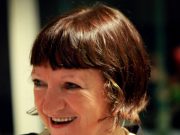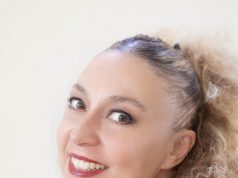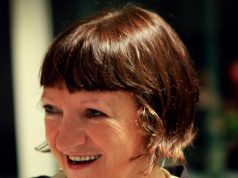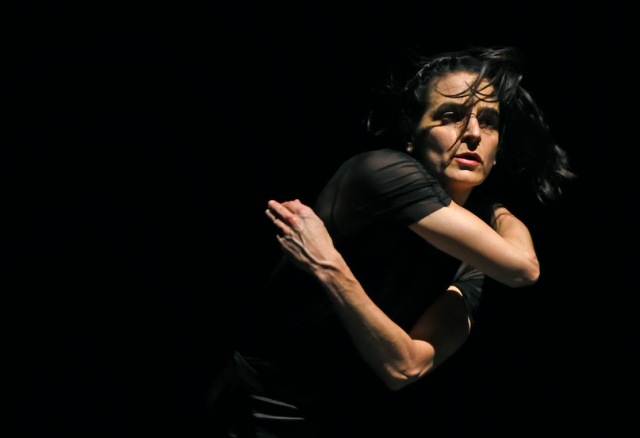
Please, scroll down for the English version.
BERLINO – Dopo aver raccolto le impressioni di coreografi, direttori di festival e centri coreutici in merito ai cambiamenti imposti al mondo della danza a causa della pandemia da Corona Virus e alle strategie lavorative adottate dai diversi operatori dello spettacolo per far fronte alla crisi, mi sono rivolto ad alcuni danzatori residenti a Berlino, ma provenienti da tutto il mondo, per conoscere le esperienze vissute e la loro opinione in merito. La prima rappresentante di questa categoria ad aver intervistato è Maria Colusi, danzatrice, insegnante e coreografa argentina, membro del Ballet Contemporáneo del Teatro San Martín di Buenos Aires, della compagnia Tangokinesis Co. e della Sasha Waltz & Guests.
A marzo 2020, quando i governi di tutti i Paesi europei hanno adottato stringenti misure di sicurezza per evitare il contagio da COVID-19, la Sasha Waltz & Guests si è vista costretta a cancellare il debutto tedesco di Remains di Andrew Schneider e a cambiare integralmente il fitto programma di spettacoli che aveva in calendario per i mesi successivi. Come hai vissuto questo cambiamento e in che modo ha influito sulla tua attività professionale?
Il 2020 si prospettava un anno ricco di impegni. Quando è cominciato, avevo un’agenda pienissima di spettacoli, festival ed eventi a cui avrei dovuto partecipare. Poi, con il lock down, molte serate sono state subito cancellate e tante altre prima sospese, a data da destinarsi, e poi man mano annullate anch’esse. Da che avevo un futuro, non l’avevo più.
Con la pandemia, la mia vita lavorativa spariva nel nulla. La situazione in cui mi sono trovata, mi ha spinto a riflettere. Ho iniziato a pensare in modo critico al sistema in cui ci troviamo, un sistema che ti chiede di produrre altrimenti non esisti e non hai valore.
Ciò mi ha spinto a chiedermi quale sia la mia posizione rispetto alle storture di questo sistema, a come vorrei che funzionassero le cose come donna, come danzatrice e insegnante. La conclusione cui sono arrivata è che voglio affermare la mia identità. Voglio essere me stessa non solo a casa, con la mia famiglia, ma anche nel mio lavoro.
Sei riuscita a tener fede al tuo proposito e ad uscire da questa impasse?
Non potendo fare progetti a lunga scadenza, mi sono resa conto che esiste solo il presente e che ci si può organizzare esclusivamente giorno dopo giorno. Per superare la paura per un futuro così incerto e una situazione lavorativa in stallo, ho dovuto far ricorso a tutte le mie risorse personali, ho guardato alle mie spalle e ricordato la mia vita in Argentina. Sono di Buenos Aires e lì, la condizione di precarietà che stiamo vivendo oggi in tutto il mondo è la norma. Avendo trascorso tanti anni in Europa, mi sono abituata anch’io a programmare ogni cosa con la certezza e le garanzie che ti offre una società ricca e produttiva. Ma nella mia città, l’arte di improvvisare è un imperativo per la sopravvivenza e questa capacità di adattamento è nel mio DNA. Mi è bastato ricordare chi sono per reagire alla crisi.
Come hai reagito? Hai organizzato anche tu le classi on line come hanno fatto in tanti?
Per circa un mese e mezzo ho dato lezioni on line. Inizialmente ero scettica, la danza non è come lo yoga o il pilates, l’energia in una sala è completamente diversa e, per me, il contatto è imprescindibile. Inoltre, a parte gli evidenti limiti di spazio, è difficile per gli alunni trovare la giusta concentrazione con uno schermo di mezzo.
Eppure, ci siamo riusciti. In qualche modo abbiamo trovato la forma e il modo di lavorare a distanza. Appena è stato possibile, però, ho ripreso a dare lezioni alla Caminada e, successivamente, alla Tanzfabrick e al Marameo. Erano classi di sole sei persone. Tutti avevano paura, ci si era disabituati a stare con altra gente.
Facevamo la classe con tutte le finestre aperte e senza avvicinarci troppo gli uni agli altri. Ho dovuto lavorare molto per riuscire a riportare l’attenzione degli alunni in sala. All’inizio era come se fossero nella loro testa. Lo vedevo nei loro movimenti, nella loro danza. Poi abbiamo parlato a lungo e qualcosa è cambiato, la testa e il corpo hanno ripreso a comunicare e l’energia a fluire.
A parte i cambiamenti a cui le scuole sono tenute per il cosiddetto distanziamento sociale, è cambiato anche il tuo modo di insegnare?
Come ti dicevo, per me il contatto e il respiro sono di vitale importanza nella danza, quindi, almeno inizialmente, ho incontrato dei limiti oggettivi e delle difficoltà nell’insegnamento.
Poi ho iniziato a percepire tutto l’universo racchiuso nello spazio tra due corpi distanti: la tensione della prossimità fisica senza contatto. Ho scoperto una nuova forma di dialogo, interessante anche da un punto di vista drammaturgico e ho trovato nuovi stimoli che hanno arricchito la mia didattica.
Ad agosto sei tornata ad esibirti al Radialsystem con la Sasha Waltz & Guests riproponendo una versione insolita di Sacre e debuttando in un’originale versione del Bolero di Ravel. A settembre, sempre con la compagnia di Sasha Waltz, ti sei esibita anche a Roma. Com’è stato tornare a danzare per un grande pubblico dopo tanti mesi di lontananza dalle scene?
È stato strano! Quest’estate, in poco più di due settimane, abbiamo montato Sacre riadattandolo alle esigenze che le direttive anti-contagio imponevano. Non c’era contatto tra noi danzatori.
Ognuno si muoveva in uno spazio circoscritto all’esterno del teatro. Indossavamo le mascherine e il pubblico, diviso in piccoli gruppi che si muovevano in percorsi prestabiliti, aveva a sua volta il viso coperto. Mentre danzavo, mi sentivo spettatrice anch’io di uno strano spettacolo. Ma, la cosa più emozionante, anche davanti al pubblico di Roma, è stata la ‘vicinanza’ al pubblico.
Se, solitamente c’è una netta demarcazione tra chi è in ribalta illuminato dalle luci e chi si trova al buio osservando ciò che accade sul palco, adesso c’era una vicinanza diversa, come se ci trovassimo tutti dallo stesso lato, uniti da un’esperienza comune tutti, che stiamo cercando di superare insieme, ognuno a suo modo.
Come giustamente osservavi, non si può che vivere il presente e continuare la nostra vita a piccoli passi, ma se potessi esprimere un desiderio, cosa ti auguri per il futuro?
Vorrei semplicemente continuare a fare il mio lavoro. Soprattutto ora, a cinquant’anni, sento di poter trasferire la mia esperienza, tutto ciò che ho imparato nella mia carriera a chi è disposto ad ‘ascoltarmi’.
In bocca al lupo, allora, e grazie mille per avermi dedicato il tuo tempo.
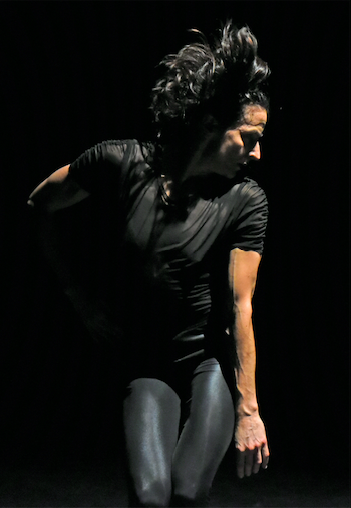
After having collected impressions from choreographers, festival directors and centers of dance of the changes imposed on the dance world due to the Corona Virus pandemic and the working strategies adopted by the various entertainment operators to cope with the crisis, I turned to some international dancers based in Berlin to learn about their experiences and their opinion on the matter. The first representative of this category I interviewed was Maria Colusi, Argentinian dancer, teacher and choreographer, member of the Ballet Contemporáneo San Martín in Buenos Aires, the Tangokinesis Co. company and also of Sasha Waltz & Guests.
In March 2020, when all the governments of European countries adopted stringent security measures to avoid the contagion of COVID-19, Sasha Waltz & Guests was forced to cancel their German debut of Remains by Andrew Schneider, as well as completely change the full company program for the following months. How did you experience this change and how did it affect your professional activity/work/job?
2020 promised to be a busy year. When it started, I had an agenda full of shows, festivals and events that I was supposed to attend. Then due to lockdown, many shows were immediately canceled and many others were at first suspended to a later date and then eventually canceled too. I went from having a future in sight to no longer having one. With the pandemic, my working life disappeared. The situation in which I found myself prompted me to reflect. I began to think critically about the system we are in; a system that asks you to produce, otherwise you don’t exist and have no value. This made me question myself and my position in relation to the distorted system and in terms of how I would like things to work: as a woman, as a dancer and as a teacher. The conclusion I have come to is that I want to affirm my identity. I want to be myself not only at home, with my family, but also in my work.
Were you able to fulfill your purpose and get out of this impasse?
Not being able to make long-term plans, I realized that there is only the present and that we can only organize ourselves day to day. To overcome the fear of such an uncertain future and a stalled job situation, I had to draw on all my personal resources, look to my past and remember my life in Argentina. I am from Buenos Aires and there, the precarious condition we are experiencing today all over the world is the norm. Having spent many years in Europe, I too became used to planning everything with the certainty and guarantees that a rich and productive society offers you. But in my city, the art of improvising is imperative to survival and this adaptability is in my DNA. It was enough for me to remember who I am and I was able to react to the crisis.
How did you react? Did you organize online classes as many others have done?
For about a month and a half I gave lessons online. Initially I was skeptical. Dance is not like yoga or pilates. The energy in a room is completely different and, for me, contact is essential. Moreover, apart from the obvious space limitations, it is difficult for pupils to find the right concentration with a screen in the middle. Still, we succeeded. Somehow we have found the form and the way to work from a distance. As soon as it was possible, however, I resumed my lessons at Caminada and then at Tanzfabrick and Marameo as well. I did classes for only six people. Everyone was afraid. We were not used to being with other people anymore. We did the class with all the windows open and without getting too close to each other. I had to work hard to be able to bring the pupils’ attention back to the room. At first it was as if they were stuck in their heads. I could see it in their movements, in the way they danced. Then we talked for a long time and something changed. The head and the body started communicating again and the energy flowed.
Apart from the changes that schools are required to make for so-called social distancing, has your way of teaching changed too?
As I told you, for me contact and breathing are of vital importance in dance, so, at least initially, I encountered objective limits and difficulties in teaching. Then I began to perceive the whole universe enclosed in the space between two distant bodies: the tension of physical proximity without contact. I discovered a new form of dialogue, which is also interesting from a dramaturgical point of view and I found new stimuli that enriched my teaching.
In August you returned to perform at the Radialsystem with Sasha Waltz & Guests re-proposing an unusual version of Sacre and debuting in an original version of Ravel’s Bolero. In September, once again with Sasha Waltz’s company, you also performed in Rome. What was it like to go back to dancing in front of a large audience after so many months away from the stage?
It was weird! This summer, in just over two weeks, we assembled Sacre, adapting it to the needs that the anti-contagion directives imposed. There was no contact between the dancers. Each of us moved in a limited space outside the theatre. We wore masks and the audience, divided into small groups that moved in predetermined paths, had their faces covered. While I was dancing, I felt like a spectator of a strange spectacle too. But the most exciting thing, even in front of the audience in Rome, was the ‘proximity’ to the public. If usually there is a clear demarcation between those who are in the spotlight and those who are in the dark observing what happens on the stage, now there was a different closeness, as if we were all on the same side, united by a shared experience, which we are trying to overcome together, each in their own way.
As you rightly observed, one can only live in the present and continue our life step by step, but if you could make one wish, what would you wish for the future?
I would just like to continue doing my job. Especially now, at the age of fifty, I feel I can transfer my experience, everything I have learned in my career to those who are willing to ‘listen to me’.







